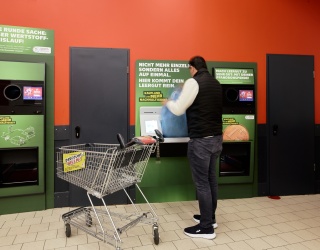The Cha-Ching sound of the cash register rings up sales – that’s music to a retailer’s ears. Satisfied customers and happy employees are the key to increasing sales.
What role does effective supply chain management play in this setting? Why should retailers always monitor their inventory levels? And why do digital technologies beat most manual processes? Christian Floerkemeier is the Vice President Product, CTO and co-founder of Scandit and has the answers to these pressing questions.

Mr. Floerkemeier, How has the coronavirus pandemic affected the supply chain?
Christian Floerkemeier: Grocery retail supply chains have seen the biggest changes. Though not as common in Europe, adjustments are evident at the global level: There is a surge in online grocery shopping. Instacart, deemed the Uber of home grocery shopping, offers grocery delivery and pick-up service in the United States and Canada and is more popular than ever. Customers visit the company’s official site - Instacart features a wide range of products from multiple retailers – to shop and place an order. An Instacart shopper then manages the order, picks up the items at the store, and delivers the groceries to the customer. As a result, Instacart has seen a phenomenal increase in order volumes amid the coronavirus outbreak. The company hired over 300,000 full-service shoppers in recent weeks to meet this surging demand. These stats show how the supply chain and e-commerce customer trends have changed and keep shifting as it relates to brick-and-mortar retail. European countries have also been a part of this development: One Italian retailer has attended to older adults and customers in need of extra assistance. Initially, there was a lack of digital infrastructure, but the retailer was able to roll out a new application after three weeks. This enabled its employees to take customer orders over the phone or email, and scan the products with a cell phone at the store. Volunteers then deliver the items to customers.
Another trend that influences the supply chain: Covid-19 has given contactless shopping and mobile self-checkout and scanning an additional boost. Most years, retailers can typically expect a five to ten percent annual growth rate. Yet transactions have in parts doubled in March and April.
Why are real-time transparency and supply chain traceability increasingly important?
Brick-and-mortar businesses are forced to compete with giants like Amazon or Zalando. In the case of the latter two, customers can access information pertaining to product selection, availability, and delivery terms. This, in turn, raises their expectations when it comes to all other retail settings. Customers can directly compare if certain products are no longer available in-store in the evening, fully aware that online marketplaces are never sold out. This is an area where brick-and-mortar stores must keep up with the competition and rise up to the challenge.
What are ways brick-and-mortar stores can optimize their supply chain process?
For the record, many retailers now rely on in-store picking, and this traditionally takes place without technical assistance, which can get tricky as manual in-store processes are weak links in your supply chain. A key to effective supply chain management for retailers is to know what’s selling in stores and to ensure on-shelf product availability. Here is one problem, though: retailers often don’t know what’s in their inventory as their IT systems don’t differentiate between the sales floor and the warehouse. As a result, retailers don’t know whether a product is physically on the shelf or whether it still has to be taken out of the box in the warehouse. Another drawback is the need for extra effort. Retailers might check price tags once a month. Yet even walking through the aisles once a day to check on-shelf inventory is not enough. Retailers must keep an eye on this and practice good inventory management to ensure customer satisfaction.

Customer satisfaction is everything - also when it comes to supply chain design. But retail employees play an important role in all this.
Employees are essentially considered the most important part of the supply chain. Here is an example of why this is the case. A French retailer tracked how many steps employees take each day. As it turned out, they walked about 15,000 steps, which is a lot. One reason they rack up many miles is when a customer has a question, the employee then proceeds to the shelf, writes down the product number, walks across the store to check with the back office and search inventory data, and then returns to the customer. All the while, the customer is kept waiting. This is frustrating for both parties. This retail example shows that digital transformation begins with the employees. A mobile inventory scanner is not enough. Plus, the device is bulky and only serves this one purpose. That’s why employees must carry their personal smartphone during their work day, featuring a camera that can be used for barcode scanning and provides access to inventory and supply chain data. This process allows retailers to give customers reliable data and it also enables employees to assist with inventory management, allowing them to correct price tags for example. This is a very tedious manual process without the use of smartphone-based augmented reality solutions.
One way to simplify processes is computer vision-based retail price label verification. That means you point the smartphone at the shelf, the smartphone software scans the barcode and automatically detects the price. An augmented reality overlay identifies whether the price is right or wrong. If it’s the latter, the employee can immediately print out a label with the correct price – thanks to a printer on the employee’s belt - and replace the price tag. This process also enables employees to reorder items at the same time. But let’s get back to the self-scanning aspect: employees also play an important role in this setting. Employees must realize the benefits of this self-checkout process as they are the ones who interact and service the customer on the retail sales floor. That’s why it is key to involve employees in all technological changes, even if these changes appear to – at first glance - only center on the customer.
How has supply chain management changed in the past 15 years?
Some aspects have not changed much since mobile data collection (MDC) devices have entered the market 30 years ago. Due to their hefty weight, they are mostly used for selective purposes. Yet even in the precarious time of Covid-19, multiple staff members still share the devices, whose functionality has actually improved very little in all these years. In contrast, commercially available smartphones can feature modern software solutions that can simultaneously read 10 to 15 barcodes. They can work more effectively using augmented reality. Heat maps on shelves can reveal sales volumes and identify popular and top-selling products, for example. New software solutions also optimize inbound logistics, making it possible to scan all the codes on a pallet at once versus having to scan each individual logistics unit. These types of processes will be a matter of course in the future.







